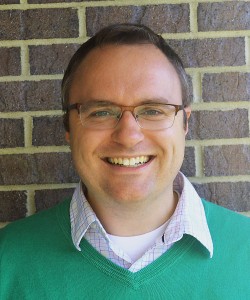An expert in nanotechnology and microfabrication recently joined Iowa State University to advance medical science with an engineering perspective.
 After watching individuals, families and communities slowly succumb to debilitating diseases – like Alzheimer’s, cancer and type-2 diabetes – throughout his life, Jonathan Claussen is determined to find a way to relieve the effects of these illnesses.
After watching individuals, families and communities slowly succumb to debilitating diseases – like Alzheimer’s, cancer and type-2 diabetes – throughout his life, Jonathan Claussen is determined to find a way to relieve the effects of these illnesses.
“I’ve seen how devastating these diseases can be,” said Claussen, who is an assistant professor in mechanical engineering at Iowa State. “I want to help detect and monitor them at an early stage to increase the odds of a promising prognosis.”
A childhood fascination for the way things worked and a high school interest in engineering led Claussen to study mechanical engineering at the University of Minnesota. During that time, he took courses on nanotechnology and microfabrication and realized the potential impact engineering at the nano/micro scale could have on the biomedical industry. He also took a one-year sabbatical to perform service work in southern Brazil that helped to solidify his interest in health-related engineering.
He received a bachelor’s degrees in mechanical engineering and Spanish and Portuguese studies (2006), and then enrolled in grad school at Purdue University.
While studying for his master’s, Claussen became interested in nanostructured biosensors that were capable of detecting biomarkers associated with diseases such as diabetes and cancer.
“Noninvasive glucose biosensors, for example, monitor glucose in saliva or interstitial fluids and can be used for disease diagnostics and treatment,” he explained.
Seeing the difference that nanotechnology could make in biomedical applications, he studied biological engineering for his Ph.D. after receiving his master’s in mechanical engineering in 2008.
For his doctorate degree, he developed electrochemical biosensors – sensors that can monitor electrical changes in solutions due to biological events – comprised of carbon nanotubes and graphene deposited onto silicon chips through chemical vapor deposition for disease diagnostics.
Biosensors, he says, can attach to skin or surface material and continually measure compounds associated with diseases or other biological processes, called biomarkers, in sweat or interstitial fluid, pathogens in a farmer’s field or food quality in a supermarket.
Claussen moved to the University of California San Diego, after receiving his Ph.D. in 2011, where he spent a year as a postdoc working on micro/nano rockets and micro needles arrays for drug delivery. He later studied optical-based biosensors comprised of semiconductor nanocrystals, called quantum dots, as a research scientist at the US Naval Research Laboratory in Washington D.C.
Now at Iowa State, Claussen brings his background in nanotechnology and microfabrication and a goal to help others learn to ISU’s classrooms.
“I chose Iowa State because it is a great engineering school that is at the forefront of scientific research and teaching,” he said. “I also love to teach and mentor students.”
And his research seems to be a perfect fit in the biological and nanoscale sciences research thrust in the mechanical engineering department, where he looks forward to creating strong and lasting collaborations with his colleagues.
He started a lab group with two major focus areas: researching ink jet printed biosensors and developing new fabrication methods for “growing” carbon nanotubes and graphene for a variety of applications including biosensing.
“These areas build upon some of my previous work, especially my Ph.D. studies,” he explained.
Carbon nanotubes and graphene provide high surface area and electrocatlyic capability that is well suited for a variety of applications, including next-generation biosensors and fuel cells.
In addition to research, Claussen is teaching ME 160 – Problem Solving with Computer Applications – this fall, and he hopes to develop a new course on biosensors and nanotechnology for students soon.
“It’s exciting to see new students come in and give them a taste of what engineering really is,” he said. “They also bring an energy and excitement to the classroom and laboratory that is quite contagious and rewarding.”